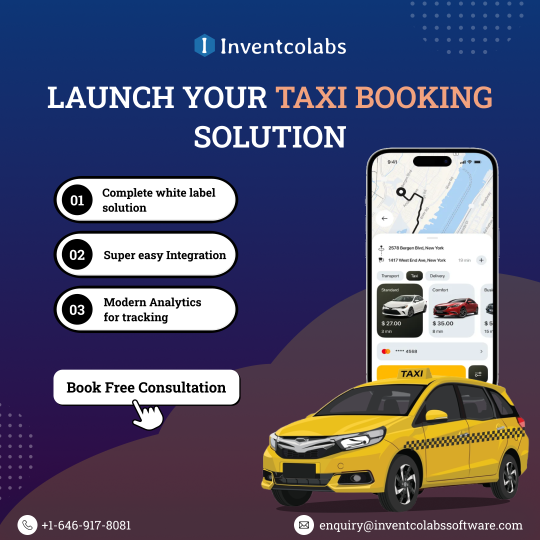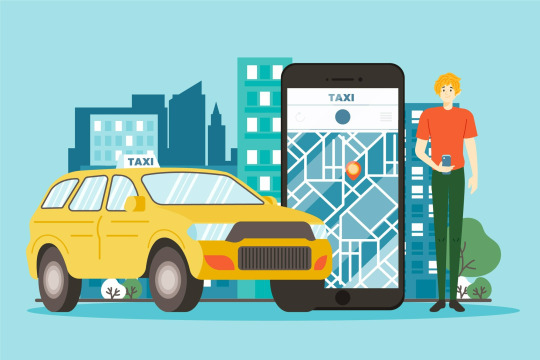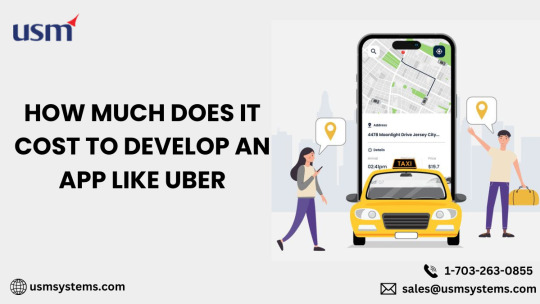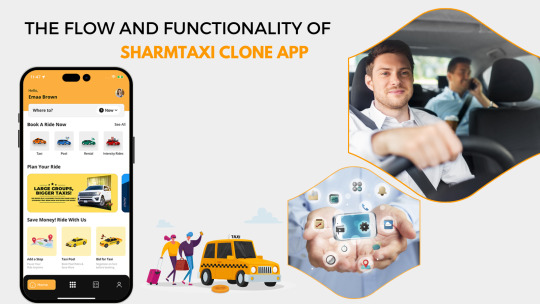#TaxiAppDevelopment
Explore tagged Tumblr posts
Text
Top Challenges Developers Face in Taxi App Development

The global demand for taxi booking apps has increased in recent years. With services like Uber, Lyft, and Ola redefining urban mobility, many startups and transport businesses are eager to launch their own taxi apps. However, developing a taxi booking app is not as simple as it may seem.
In this article, we’ll explore the top challenges developers and businesses face while taxi app development and how to address them effectively.
1. Real-Time GPS Tracking and Navigation
Challenge: Accurate location tracking is critical for both drivers and passengers. GPS glitches, incorrect routing, or slow updates can lead to poor user experience.
Solution: Use reliable mapping APIs like Google Maps, Mapbox, or HERE, and implement fallback mechanisms in case of location loss. Optimize background location tracking for minimal battery drain.
2. Handling Real-Time Requests and Matching Algorithms
Challenge: Managing hundreds or thousands of users requesting rides simultaneously requires an efficient matching algorithm that pairs drivers and riders in real-time.
Solution: Leverage robust backend technologies like Node.js, Redis, and socket-based communication. Implement load balancing and use location clustering to improve request distribution.
3. Secure and Seamless Payments
Challenge: Integrating secure payment methods, supporting various currencies, and offering multiple payment options (card, wallet, UPI, etc.) can be complex and regulated.
Solution: Use PCI-DSS-compliant gateways like Stripe, Razorpay, or Braintree. Enable tokenization for user data security and offer localized payment solutions for different markets.
4. Multi-Platform Compatibility (iOS & Android)
Challenge: Ensuring consistent performance and user experience across both Android and iOS devices, while keeping taxi booking app development cost-efficient, is a major challenge.
Solution: Consider cross-platform frameworks like Flutter or React Native to reduce development time while maintaining quality. For larger enterprises, native development might be preferred.
5. Scalability and Performance
Challenge: Taxi apps must be ready to scale as user demand grows—especially during peak times or geographic expansion.
Solution: Use a microservices architecture, cloud hosting (AWS, GCP, Azure), and scalable databases like MongoDB or PostgreSQL. Regularly stress-test your infrastructure.
6. Data Privacy and Compliance
Challenge: Handling user data, real-time locations, and payment information requires strict adherence to privacy regulations like GDPR, HIPAA, or local laws.
Solution: Implement end-to-end encryption, anonymize location data where needed, and maintain transparency with users about data usage. Always comply with region-specific legal standards.
7. Managing Driver and Rider Behavior
Challenge: Ensuring reliable service means managing unpredictable human behavior, cancellations, fraud, late arrivals, or disputes.
Solution: Build features like ratings, feedback, SOS buttons, cancellation policies, and in-app support. Use AI or pattern recognition to detect suspicious activity.
8. Localization and Market Adaptation
Challenge: If you're targeting multiple regions or countries, your app must adapt to different languages, currencies, traffic laws, and cultural expectations.
Solution: Design your app with multi-language support, real-time currency conversions, and local holiday/surge pricing logic. Understand the local ecosystem before launching.
9. Integrating Advanced Features
Challenge: Modern users expect more than just booking. Features like ride scheduling, fare splitting, loyalty programs, or AI-based ETA predictions can be hard to implement well.
Solution: Start with an MVP (Minimum Viable Product), then gradually introduce features. Use AI and machine learning for predictive analytics and route optimization.
Final Thoughts
Building a successful taxi app requires more than just sleek design and smooth booking flows. It demands technical expertise, infrastructure planning, regulatory compliance, and a deep understanding of user behavior. By being aware of these challenges upfront, you can develop more robust, user-friendly, and scalable on-demand taxi booking apps.
0 notes
Text
Indriver Clone App by Appicial – The Smartest Way to Launch a Taxi Business
Indriver Clone App by Appicial – The Smartest Way to Launch a Taxi Business
Introduction
The global ride-hailing market is booming, and the demand for flexible, user-friendly platforms is at an all-time high. One of the standout models is InDriver, which revolutionized the ride-hailing industry by allowing passengers and drivers to negotiate prices directly. If you're an entrepreneur looking to tap into this lucrative industry, building an Indriver clone app is a smart way to enter the market without reinventing the wheel.
In this blog, we will explore how Appicial's Indriver Clone App offers a fast, scalable, and cost-effective solution to help you launch your very own ride-hailing business with the same features and functionalities as InDriver. Let’s dive into why this clone app is the smartest choice for your taxi business.
What Is an Indriver Clone App?
An Indriver Clone App is a white-label solution that replicates the key features of the InDriver platform. The main distinguishing feature of the InDriver app is its unique fare negotiation system. Unlike other ride-hailing apps, passengers can propose a fare, and drivers can either accept, reject, or counter the offer. This system promotes transparency and flexibility, making it a favorite among both drivers and riders.
Appicial's Indriver Clone App offers a ready-to-launch platform with customizable features, allowing you to start your taxi business efficiently and at a low cost.
Why Choose the Indriver Clone App by Appicial?
Customizable Features Appicial’s Indriver Clone App comes with flexible and customizable features to suit your specific business needs. Whether you’re targeting price-sensitive customers or offering premium services, the app can be tailored to match your vision.
Fare Negotiation System The key feature of the Indriver Clone is the fare negotiation system. Passengers can set a price, and drivers can either accept or suggest a new fare. This system promotes transparency and mutual respect between drivers and passengers.
User-Friendly Interface Appicial’s Indriver Clone App boasts an intuitive interface for both passengers and drivers, making it easy for users of all ages to navigate the app. Simple, effective, and engaging designs ensure a smooth experience for everyone involved.
Real-Time GPS Tracking The app integrates real-time GPS tracking, allowing passengers to track their driver’s location and estimated arrival time. This feature increases trust and transparency in the service, enhancing the overall user experience.
Multiple Payment Options The app supports a range of payment options including credit/debit cards, digital wallets, and cash, allowing users to choose the payment method that’s most convenient for them.
Scalable and Secure Built on a robust and scalable platform, Appicial’s Indriver Clone App can handle increasing traffic and data, making it the perfect solution for businesses looking to expand. The app is also designed with top-notch security measures to protect user data and transactions.
Key Features of Appicial’s Indriver Clone App
🧍 For Riders:
Fare Bidding – Riders suggest their fare, and drivers can negotiate.
Real-Time Trip Tracking – Riders can track their ride in real-time.
Multiple Payment Methods – Choose from cash, wallet, or card.
Ratings and Reviews – Riders can rate drivers based on the quality of the ride.
Ride History – Keep track of all your previous rides.
🚗 For Drivers:
Accept/Reject/Counter Offers – Drivers can negotiate fares with passengers.
Online/Offline Mode – Drivers can toggle their availability.
Trip History & Earnings – Drivers can access past trip details and earnings.
Navigation – In-app GPS navigation for optimal routes.
Instant Notifications – Get notified of new ride requests instantly.
🛠️ Admin Panel:
User Management – Admins can manage both riders and drivers.
Trip Monitoring – Track the status of all active rides in real-time.
Fare Control – Set base fares and monitor negotiations.
Reports & Analytics – View detailed reports and analytics of app usage.
Commission Settings – Set the commission percentage from drivers.
Technology Stack Used for Indriver Clone App
ComponentTechnologyFrontend (App)Flutter / React Native / KotlinBackendNode.js / PHP (Laravel) / PythonDatabaseMongoDB / MySQL / PostgreSQLGPS/MapsGoogle Maps API / MapboxReal-time ChatFirebase / Socket.ioPayment GatewayStripe, Razorpay, PayPal, etc.
How to Launch Your Taxi Business with Indriver Clone App?
Market Research Before launching, research the market, your target audience, and the competition. Understanding your local demand will help you shape your business and app strategy effectively.
Choose a Development Partner Choose a reliable app development company like Appicial that specializes in ride-hailing apps and has experience in delivering high-quality, scalable solutions.
Customizations & Branding Customize your app's look and feel to match your branding. Appicial provides a white-label solution, allowing you to make changes in the app design, logo, and colors to reflect your brand identity.
App Development & Testing Appicial’s team will help you build the app, integrate essential features, and ensure it works flawlessly. Rigorous testing ensures the app runs smoothly on both Android and iOS devices.
Launch & Marketing After your app is ready, it’s time to launch. Promote your app through social media, online ads, and local marketing campaigns to attract drivers and riders.
Continuous Monitoring & Improvement Once the app is live, keep monitoring its performance and user feedback. Appicial offers post-launch support and maintenance, ensuring the app stays up-to-date and bug-free.
Cost of Building an Indriver Clone App
The cost of building an Indriver clone app can vary based on several factors such as features, customizations, and the development company you choose. On average, the cost may range between:
Basic App (MVP): $5,000 to $8,000
Full-Featured App: $10,000 to $20,000+
The investment in building a feature-rich and customizable app can bring great returns in the competitive ride-hailing industry.
Conclusion
Launching a taxi business with an Indriver Clone App by Appicial is the smartest way to enter the booming ride-hailing market. With its unique fare negotiation feature, user-friendly interface, and customizable solutions, Appicial's Indriver Clone App gives you the tools you need to create a scalable, efficient, and profitable business.
By partnering with Appicial, you can save time, money, and effort in developing a top-notch ride-hailing platform. Ready to launch your taxi business? Get in touch with Appicial today to start your journey toward success in the ride-hailing industry!
#TaxiBusiness#AppDevelopment#RideHailingApp#CloneApp#SmartTaxiApp#TaxiStartup#Appicial#RideHailingBusiness#TaxiAppDevelopment
1 note
·
View note
Text
Launch Your Taxi Booking Solution
The taxi service industry is shifting gears and making serious strides in the business world!
Innovators aren’t stopping at just cars or bikes—they’re launching out-of-the-box taxi solutions that are changing the game.
Want to launch your own innovative taxi solution?
Book your free consultation with our development experts now!
Visit Us: https://www.inventcolabssoftware.com/taxi-app-development

#taxiappdevelopment#taxiservice#taxi dispatch software#taxiapp#appdevelopment#mobileappdevelopment#techinnovation#techtrends#digitalinnovation
0 notes
Text
Start your ride-hailing service fast with our Uber clone app. Launch in weeks with a powerful, customizable platform built for performance, user satisfaction, and business growth from day one.
0 notes
Text

Technology has a significant importance in our society and is increasingly essential in our everyday lives. main reasons why technology is so important
1 note
·
View note
Text

Backend development is crucial for managing ride requests, payments, and user authentication. You can use cloud-based solutions like AWS or Google Cloud for secure data handling. For seamless user experience, integrate third-party APIs like Google Maps for navigation and Twilio for SMS notifications. Additionally, implementing an AI-driven algorithm for optimal ride matching can improve efficiency. Testing your app thoroughly before launch ensures smooth functionality. Once deployed, continuous updates and marketing strategies will help you compete in the market. For a step-by-step guide on creating an app like Uber in 2024, visit this link: https://www.intelegain.com/creating-an-app-like-uber-in-2024-step-by-step-process-and-key-factors/
#TaxiAppDevelopment#BuildUberLikeApp#RideSharingApp#UberClone#AppDevelopment#TaxiBookingApp#OnDemandApp#MobilitySolutions#RideHailingApp#AppDevelopment2024#StartupIdeas#TechInnovation#MobileAppDevelopment#AIinTransport#TaxiBusiness#UberAlternative#SmartTransport#AppDevelopmentGuide#Entrepreneurship#AppTech
0 notes
Text
#TaxiDispatchSoftware#CabManagement#FleetManagement#TaxiAppDevelopment#TransportationTech#RideHailingSolutions#SmartDispatch#CabBookingSystem#TaxiServiceSoftware#DigitalTransportation
0 notes
Text

How much does it cost to develop an app like Uber
Developing an app like Uber involves various factors, including user interface design, GPS integration, payment gateways, and backend development. The cost depends on the complexity of features like real-time tracking, driver-partner interface, and customer support. Creating a robust ride-sharing app requires expertise in handling large user bases and seamless functionality. For premium app development services, USM Business Systems is the best mobile app development company, offering tailored solutions to meet your business needs.
#UberAppCost#AppDevelopmentCost#UberCloneApp#RideSharingApp#TaxiAppDevelopment#AppLikeUber#MobileAppCost#RideSharingTech#UberCloneDevelopment#TaxiBookingApp
0 notes
Text
Rideshare App Development: Trends, Models, and Top Apps to Watch in 2024

Interested in developing a taxi-booking app? 🚖 Dive into the world of ridesharing apps that are transforming public transport, reducing road congestion, and fighting climate change. Learn about the popular app models, including peer-to-peer and aggregator models, and discover which rideshare app fits your needs. Get the latest stats on Lyft, Uber, Ola, and more to make informed decisions for your development project. 📲 read more : https://on-demand-app.com/top-rideshare-apps-driving-on-demand-shared-mobility
0 notes
Text
Why Startups Are Investing in White-Label Taxi App Solutions?

In the fast-evolving ride-hailing industry, time-to-market, cost-efficiency, and scalability are everything. That’s why more and more startups are ditching expensive, built-from-scratch taxi app development and turning to white-label taxi app solutions to get ahead—faster and smarter.
If you’re a startup founder or entrepreneur considering creating Uber-like platform, this article will explain why white-label taxi apps are becoming the go-to solution for mobility innovation.
What Is a White-Label Taxi App?
A white-label taxi app is a pre-built, customizable ride-hailing software solution that startups can rebrand and launch under their own name. It includes essential modules for:
Riders
Drivers
Admins
Dispatchers
The core technology is already developed—startups simply add their branding, make minor feature customizations, and go live in weeks instead of months.
Why Startups Prefer White-Label Taxi App Solutions?
1. Faster Time to Market
Launching quickly is critical for startups. With a white-label app, you can go live in as little as 2–4 weeks, compared to 4–6 months for custom builds.
2. Cost-Efficient Development
Building a taxi app from scratch in markets like the U.S. or UAE can cost $50,000 to $120,000+. A white-label solution drastically reduces costs by up to 70%, making it ideal for lean budgets.
3. Proven Technology
You're not reinventing the wheel. White-label platforms have already been tested and refined in real-world scenarios—meaning fewer bugs, more stability, and better user experiences.
4. Custom Branding and UI
Even though the backend is pre-built, you still get to customize:
Your logo and colors
UI elements
Language preferences
Currency settings
Payment gateways This ensures your app feels unique to your audience.
5. Multi-Region Expansion
Planning to expand into multiple cities or countries? Many white-label solutions support:
Multi-currency
Multi-language
Zone-based pricing
This makes scaling your startup seamless.
6. Quick Iteration and Updates
Because the framework is already in place, it’s easier to introduce updates, test new features, and roll out app improvements without major downtime.
7. Post-Launch Support
Reputable white-label app providers often offer technical support, server management, bug fixes, and feature upgrades—freeing you to focus on operations and growth.
Ideal Use Cases for White-Label Taxi Apps?
Local taxi companies competing with Uber or Lyft
Startups launching in Tier 2 and Tier 3 cities
Niche ride-hailing services (e.g., women-only, corporate, healthcare)
Entrepreneurs in emerging markets with budget constraints
EV-based taxi fleet operators
Conclusion
White-label taxi app development gives startups a powerful head start in a competitive market. You save time, money, and development headaches, without compromising on quality or control.
At IMG Global Infotech, we help startups launch high-performing traditional taxi or EV taxi booking apps through our robust white-label solutions. Whether you're targeting Dubai, New York, Lagos, or Mumbai, we’ve got you covered.
0 notes
Text
Flow And Functionality Of Sharmtaxi Clone App
Sharmtaxi Clone is a Cash Cow for Millions of Entrepreneurs within the United States of America itself.

#cubetaxi#sharmtaxiclone#appfunctionality#userexperience#taxiappdevelopment#seamlessflow#ridehailing
1 note
·
View note
Text
How to Develop a Taxi App Like Bolt: Features, Cost & Process
Learn how to develop a taxi app like Bolt with expert insights into taxi app development. Discover key features, cost estimation, and a step-by-step process for a successful ride-hailing app.

#taxiappdevelopment#taxibusiness#taxi dispatch software#taxiapp#taxiservice#appdevelopment#mobileappdevelopment#appdevelopmentcompany#techinnovation#softwaredevelopment#techtrends
0 notes
Text
Offer the people of Malaysia and tourists with a seamless travel around the country with Uber Clone App and snazzy features.
#v3cube#uberclone#taxiappdevelopment#malaysiatech#mobileappdevelopment#startupmalaysia#appentrepreneur
1 note
·
View note
Text
How Can You Make Taxi Booking Software?
Travel has changed dramatically as a result of the emergence of on-demand services and taxi booking apps. Users can book trips, track drivers, and make payments with these apps very easily—all from the convenience of their phones. Businesses can take advantage of this great chance to join the rapidly expanding ride-hailing market and give clients a smooth travel experience by creating taxi…
0 notes
Text
On Demand Taxi Booking App Development Company
DQOT Solutions is the best on demand taxi app development company in India. Our taxi app developers can help you develop an app for your business at an affordable price.
#AppDevelopmentSolutions#TaxiAppDevelopment#AndroidAppDevelopment#iOSAppDevelopment#GPSIntegration#PaymentGatewayIntegration#CustomAppDevelopment#FleetManagement
1 note
·
View note
Text
How to Build a Taxi App Like Uber
Building a taxi app like Uber requires a strategic approach that includes market research, feature planning, and robust technology integration. Start by identifying your target audience and understanding their needs to design a seamless user experience. Your app should have three key components: a rider app, a driver app, and an admin panel. Essential features include real-time ride tracking, fare estimation, multiple payment options, and a rating system. Choosing the right technology stack, such as React Native for cross-platform apps and Firebase for real-time data sync, can significantly enhance performance and scalability.
Backend development is crucial for managing ride requests, payments, and user authentication. You can use cloud-based solutions like AWS or Google Cloud for secure data handling. For seamless user experience, integrate third-party APIs like Google Maps for navigation and Twilio for SMS notifications. Additionally, implementing an AI-driven algorithm for optimal ride matching can improve efficiency. Testing your app thoroughly before launch ensures smooth functionality. Once deployed, continuous updates and marketing strategies will help you compete in the market.
For a step-by-step guide on creating an app like Uber in 2024, visit this link: https://www.intelegain.com/creating-an-app-like-uber-in-2024-step-by-step-process-and-key-factors/
#TaxiAppDevelopment#BuildUberLikeApp#RideSharingApp#UberClone#AppDevelopment#TaxiBookingApp#OnDemandApp#MobilitySolutions#RideHailingApp#AppDevelopment2024#StartupIdeas#TechInnovation#MobileAppDevelopment#AIinTransport#TaxiBusiness#UberAlternative#SmartTransport#AppDevelopmentGuide#Entrepreneurship#AppTech
0 notes